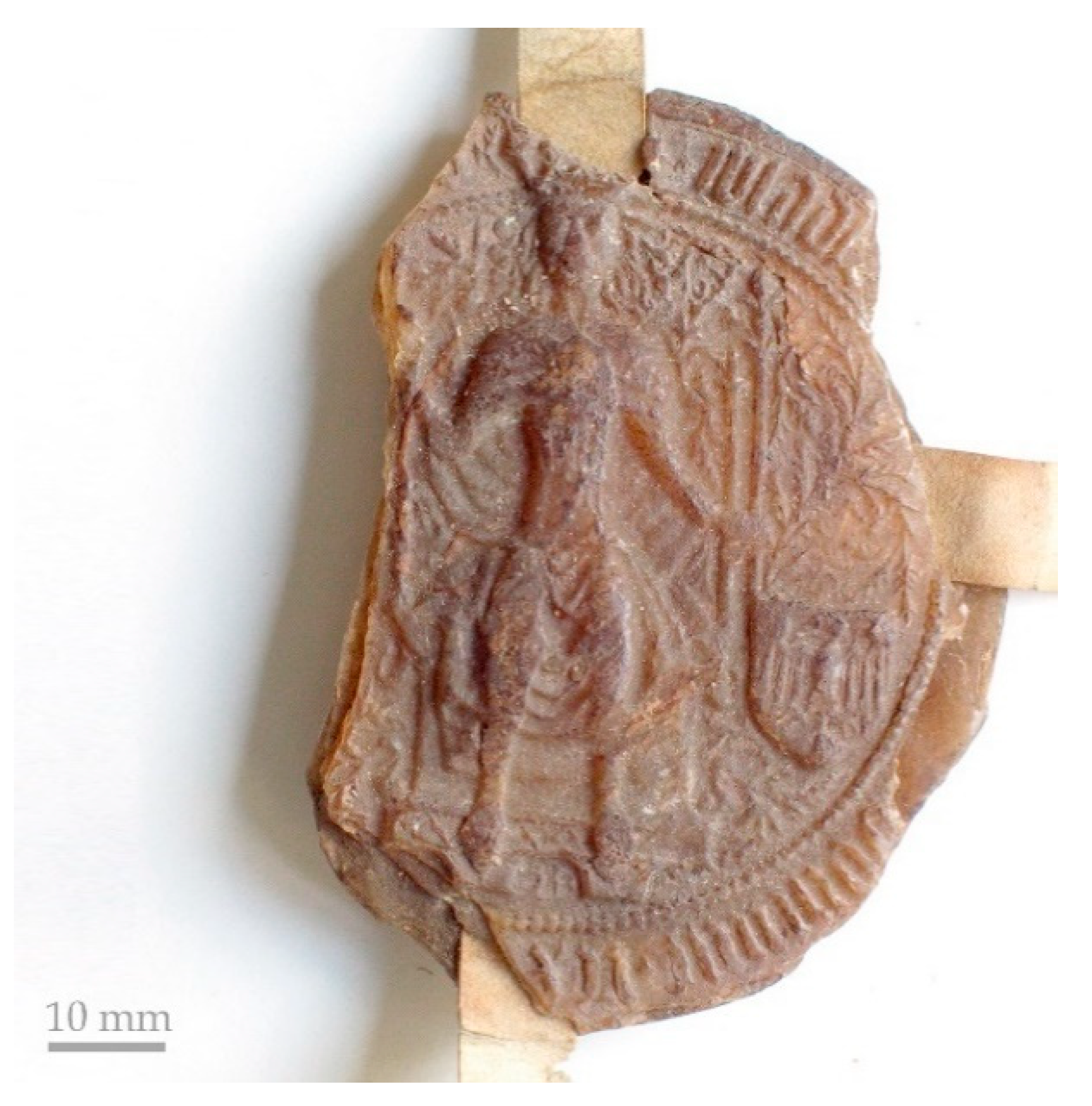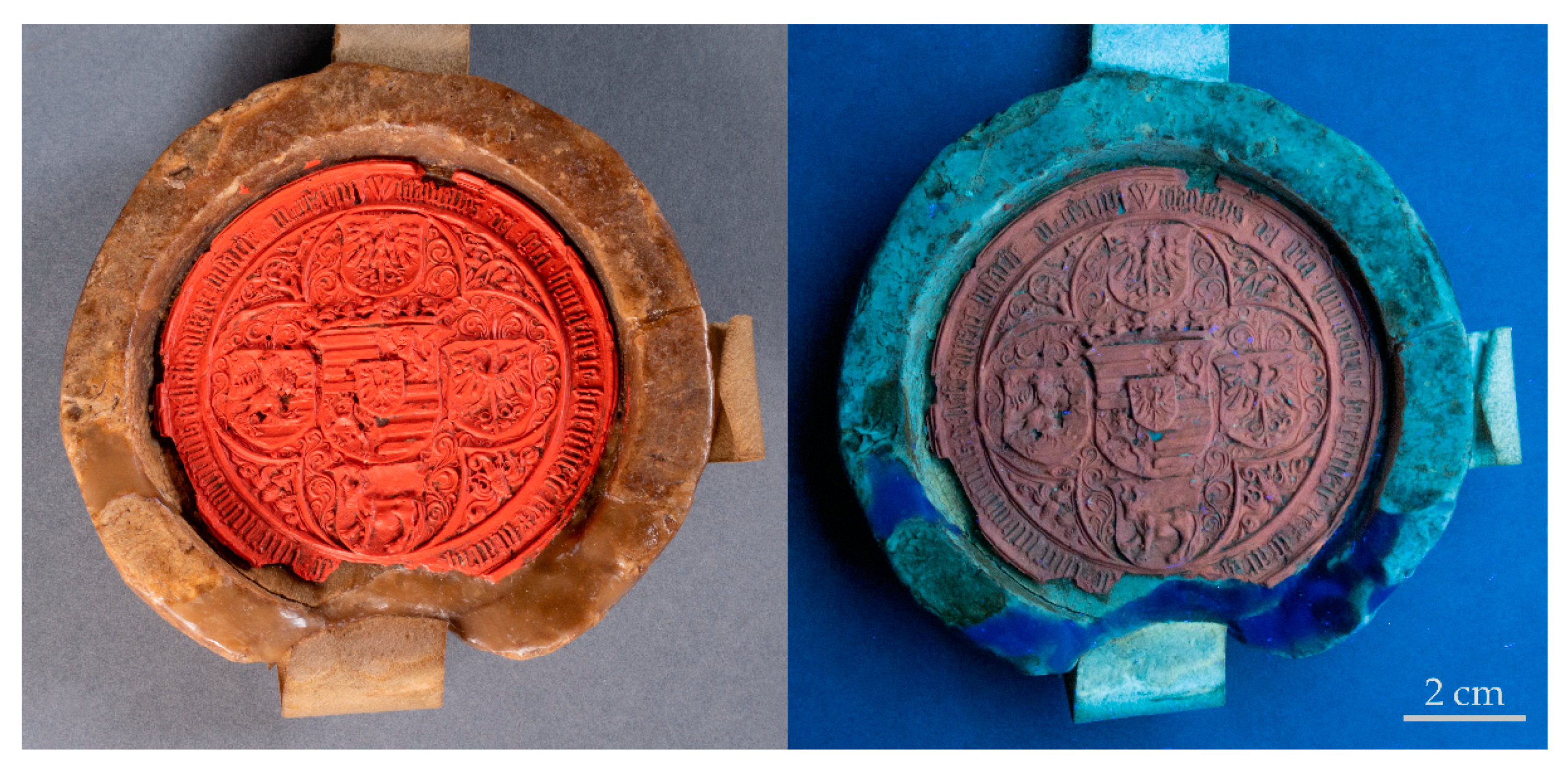Evaluation of Permulgin 3274 as a Material for the Conservation of Beeswax Seals
Abstract
:1. Introduction
2. Materials and Methods
2.1. Samples
2.2. Methods
2.2.1. Chemical Composition
2.2.2. Physical Properties
2.2.3. Working Properties
2.2.4. Stability
3. Results and Discussion
3.1. Chemical Composition
3.2. Physical Properties
3.2.1. The Peak Melting Temperature
3.2.2. Drop Point
3.2.3. Viscosity of Molten Samples at Different Temperatures
3.2.4. Thermal Volume Expansion
3.2.5. Mechanical Properties
3.3. Working Properties
3.3.1. Mechanical Processing
3.3.2. Colour Adjustment
3.3.3. Fluorescence
3.4. Stability
3.4.1. Chemical Composition
3.4.2. Optical Properties
3.4.3. “Wax Bloom”
4. Conclusions
- Absence of the “wax bloom” phenomenon
- Distinguishable from the original on the basis of its fluorescence, which occurs when exposed to the UV radiation (not in the case of the hydrogenated derivative)
- Relatively high viscosity of its melt reduces the sedimentation rate of pigments added to the mixture
- Very good stability, even when exposed to light (especially the hydrogenated derivative)
- Adequate hardness and bending strength.
- 1.
- Necessity of colour adjustment
- 2.
- Somewhat higher temperatures are required during the casting processes
- 3.
- Not so naturally available when compared to beeswax
- 4.
- Inauthentic material.
Author Contributions
Funding
Institutional Review Board Statement
Informed Consent Statement
Data Availability Statement
Conflicts of Interest
References
- Bartl, B.; Zapletal, M.; Urbánek, Š.; Krejčí Slavíková, M.; Trejbal, J.; Hrdlička, Z. Why Do Historical Beeswax Seals Become Brittle Over Time? Stud. Conserv. 2019, 64, 138–145. [Google Scholar] [CrossRef]
- Bílková, L.; Bartl, B.; Urbánek, Š.; Zapletal, M.; Holakovská, L. Voskové směsi pro restaurování historických voskových pečetí. In Certified Method No. 4; Ministerstvo Vnitra České Republiky, Odbor Archivní Správy a Spisové Služby: Praha, Czech Republic, 2020. [Google Scholar]
- Bartl, B.; Trejbal, J.; Ďurovič, M.; Vašíčková, S.; Valterová, I. Analysis of efflorescence on surface of beeswax seals. J. Cult. Herit. 2012, 13, 275–284. [Google Scholar] [CrossRef]
- Wöllfert, H. Konservierung und Ausbesserung von Archivalien. Arch. Z. 1939, 45, 1–16. [Google Scholar] [CrossRef]
- Koch, H. Konservierung und Restaurierung von Wachssiegeln. Archivmittleilungen 1958, 3, 86–89. [Google Scholar]
- Wächter, O. Restaurierung und Erhaltung von Büchern, Archivalien und Graphiken; Hermann Böhlaus Nachf. GmbH: Wien, Austria, 1975; pp. 184–189. [Google Scholar]
- Jones, M. Seal Repair, Moulds and Casts. Pap. Conserv. 1976, 1, 12–18. [Google Scholar] [CrossRef]
- Woods, C. The nature and treatment of wax and shellac seals. J. Soc. Arch. 1994, 15, 203–214. [Google Scholar] [CrossRef]
- Kukánová, Z.; Šejharová, J. Metody konzervování a restaurování pečetí. In Konzervování a Restaurování Archiválií a Knih; Ďurovič, M., Ed.; Ladislav Horáček–Paseka: Praha a Litomyšl, Czech Republic, 2002; pp. 277–316. [Google Scholar]
- Albrecht-Kunszeri, G.; (Magyar Országos Levéltár, Budapest, Hungary). Personal communication, 2003.
- Atelier Strebel, A.G. Preservation and Conservation of Karolingian and Ottonian Charters at the Episcopal Archives of the Diocese of Choir, Switzerland. Available online: https://atelierstrebel.ch/_tmc_daten/File/Oxford_2007_Chart_and_Seal.pdf (accessed on 13 July 2010).
- Janssens, M.; (Stadtarchiv Neuss, Neuss, Germany). Personal communication, 2010.
- Czajka, A.; (Archiwum Glowne Akt Dawnych, Warszawa, Poland). Personal communication, 2011.
- Spaabaek, L.R. The conservation and reconstruction of wax seals. In Care and Conservation of Manuscripts; Driscoll, M.J., Ed.; Museum Tusculanum Press: Copenhagen, Denmark, 2012; pp. 17–23. [Google Scholar]
- Speranza, L.; Gabriellini, C.H.; Cordua, M.G.; Nepi, C.H.; Rossi, F. Il Giardino Rifiorito. Il Restaro Delle Cere Botaniche Del Museo di Storia Naturale di Firenze; Museo dell’Opificio delle Pietre Dure: Firenze, Italy, 2017. [Google Scholar]
- Viñas, V. Wax seals. In Traditional Restoration Techniques: A RAMP Study; General Information Programme and UNISIST: UNESCO: Paris, France, 1988. [Google Scholar]
- Freund, M.; Csikos, R.; Keszthelyi, S.; Mózes, G.Y. Paraffin Products. Properties, Technologies, Applications; Elsevier Scientific Publishing Company: Amsterdam, Netherlands, 1982. [Google Scholar]
- Wolfmeier, U.; Schmidt, H.; Heinrichs, F.-L.; Michalczyk, G.; Payer, W.; Dietsche, W.; Boehlke, K.; Hohner, G.; Wildgruber, J. Waxes. In Ullmann’s Encyclopedia of Industrial Chemistry; Wiley-VCH: Weinheim, Germany, 2000. [Google Scholar]
- NIIR Board of Consultants & Engineers. The Complete Technology Book on Wax and Polishes; Asia Pacific Business Press: Delhi, India, 2006; ISBN-10: 8178330121. [Google Scholar]
- Lluveras, A.; Bonaduce, I.; Andreotti, A.; Colombini, M.P. GC/MS Analytical Procedure for the Characterization of Glycerolipids, Natural Waxes, Terpenoid Resins, Proteinaceous and Polysaccharide Materials in the Same Paint Microsample Avoiding Interferences from Inorganic Media. Anal. Chem. 2010, 82, 376–386. [Google Scholar] [CrossRef] [PubMed]
- Minakov, D.A.; Kartsova, L.A.; Zakharova, A.M.; Grinshtein, I.L.; Minakova, O.V. Detailed Hydrocarbon Analysis of Petroleum Products by Gas Chromatography–Mass Spectrometry. J. Anal. Chem. 2021, 76, 834–843. [Google Scholar] [CrossRef]
- Feng, Z.-H.; Fanf, W.; Zhang, J.-H.; Li, Z.-G.; Huang, C.-Y.; Wang, X.; Zhao, Q.-L.; Huo, Q.-L. Distribution and significance of C40 alkanes in the extracts of Cretaceous source rocks from the Songliao Basin. Sci. China Ser. D Earth Sci. 2007, 50, 1510–1520. [Google Scholar] [CrossRef]
- Q-Lab: A Choice of Filters for Q-SUN Xenon Test Chambers. In Technical Bulletin LX-5060; 2014; Available online: https://www.q-lab.com/documents/public/40a33eb5-8bf9-4501-85d9-10f0b66aa254.pdf (accessed on 24 February 2022).
- Bartl, B.; Kobera, L.; Drábková, K.; Ďurovič, M.; Brus, J. ‘Wax bloom’ on beeswax cultural heritage objects: Exploring the causes of the phenomenon. Magn. Reson. Chem. 2015, 53, 509–513. [Google Scholar] [CrossRef] [PubMed]
- Koster-Keunen. Permulgin 3274: Product Details. Available online: https://www.kosterkeunen.eu/eu/product-finder/e00136-permulgin-3274/ (accessed on 5 January 2022).
- Klemchuk, P.P. Influence of Pigments on the Light Stability of Polymers: A Critical Review. Polym. Photochem. 1983, 3, 1–27. [Google Scholar] [CrossRef]
- Szadkowski, B.; Kuśmierek, M.; Rybiński, P.; Żukowski, W.; Marzec, A. Application of Earth Pigments in Cycloolefin Copolymer: Protection against Combustion and Accelerated Aging in the Full Sunlight Spectrum. Materials 2020, 13, 3381. [Google Scholar] [CrossRef] [PubMed]















| Material | Tm (Peak)/°C | Drop Point/°C |
|---|---|---|
| Permulgin 3274 | 60 | 82 |
| Permulgin 3274 (hydrogenated) | 60 | 83 |
| Beeswax | 63 | 66 |
| Beeswax (hydrogenated) | 65 | 67 |
| Material | Hardness Shore D/15 s | Flexural Strength/ MPa | Flexural Modulus/ MPa | Flexural Strain at Break/ % |
|---|---|---|---|---|
| Permulgin 3274 | 10.6 ± 0.9 | 2.7 ± 1.2 | 272 ± 38 | 2.8 ± 0.2 |
| Permulgin 3274 (hydrogenated) | 10.2 ± 0.8 | 3.5 ± 0.2 | 310 ± 47 | 3.7 ± 0.5 |
| Beeswax | 7.1 ± 0.4 | 2.5 ± 0.1 | 255 ± 31 | 12.8 ± 2.2 |
| Beeswax (hydrogenated) | 20.4 ± 0.8 | 5.5 ± 0.8 | 757 ± 53 | 1.2 ± 0.2 |
| Material | ΔDR |
|---|---|
| Permulgin 3274 | 0.95 ± 0.08 |
| Recent beeswax | 1.45 ± 0.09 |
| Hydrogenated beeswax | 0.55 ± 0.09 |
| Material | Unaged | UV-Vis Aged |
|---|---|---|
| Permulgin 3274 | 0.0 ± 0.00 | 0.50 ± 0.10 |
| Permulgin 3274 (hydrogenated) | 0.01 ± 0.01 | 0.33 ± 0.01 |
| Parameter | Ageing Type | Exposure | Permulgin 3274 | Permulgin 3274 (Hydrogenated) | Recent Beeswax |
|---|---|---|---|---|---|
| L* | Reference | 0 h | 81.30 ± 0.17 | 82.33 ±0.19 | 72.13 ± 0.16 |
| UV-vis aged | 120 h | 79.74 ±0.19 | 82.52 ± 0.27 | 72.65 ± 0.07 | |
| 240 h | 80.03 ± 0.07 | 82.68 ± 0.35 | 73.38 ± 0.04 | ||
| Vis aged | 120 h | 81.95 ± 0.22 | 83.09 ± 0.08 | 73.32 ± 0.25 | |
| 240 h | 81.79 ± 0.25 | 83.01 ± 0.17 | 73.85 ± 0.11 | ||
| a* | Reference | 0 h | 0.58 ± 0.03 | 0.51 ± 0.04 | −1.87 ± 0.03 |
| UV-vis aged | 120 h | 0.45 ± 0.01 | 0.45 ±0.03 | −0.36 ± 0.05 | |
| 240 h | 0.44 ± 0.01 | 0.46 ± 0.01 | −0.46 ± 0.02 | ||
| Vis aged | 120 h | 0.55 ± 0.01 | 0.47 ± 0.03 | −0.88 ± 0.07 | |
| 240 h | 0.54 ± 0.01 | 0.49 ± 0.03 | −0.89 ± 0.04 | ||
| b* | Reference | 0 h | 4.26 ± 0.07 | 3.56 ± 0.09 | 49.25 ± 0.13 |
| UV-vis aged | 120 h | 6.84 ± 0.05 | 4.12 ± 0.06 | 34.75 ± 0.33 | |
| 240 h | 6.84 ± 0.04 | 4.15 ± 0.04 | 31.55 ± 0.06 | ||
| Vis aged | 120 h | 4.44 ± 0.03 | 3.53 ± 0.06 | 34.20 ± 0.57 | |
| 240 h | 4.61 ± 0.03 | 3.56 ± 0.12 | 30.24 ± 0.20 | ||
| ΔEab* | UV-vis aged | 120 h | 3.0 ± 0.1 | 0.6 ± 0.1 | 14.6 ± 0.4 |
| 240 h | 2.9 ± 0.1 | 0.7 ± 0.2 | 17.8 ± 0.1 | ||
| Vis aged | 120 h | 0.7 ± 0.3 | 0.5 ± 0.3 | 15.1 ± 0.6 | |
| 240 h | 0.6 ± 0.2 | 0.4 ± 0.3 | 19.1 ± 0.2 |
Publisher’s Note: MDPI stays neutral with regard to jurisdictional claims in published maps and institutional affiliations. |
© 2022 by the authors. Licensee MDPI, Basel, Switzerland. This article is an open access article distributed under the terms and conditions of the Creative Commons Attribution (CC BY) license (https://creativecommons.org/licenses/by/4.0/).
Share and Cite
Bílková, L.; Bartl, B.; Urbánek, Š.; Zapletal, M.; Holakovská, L.; Ďurovič, M.; Hrdlička, Z.; Havlín, J. Evaluation of Permulgin 3274 as a Material for the Conservation of Beeswax Seals. Materials 2022, 15, 1909. https://doi.org/10.3390/ma15051909
Bílková L, Bartl B, Urbánek Š, Zapletal M, Holakovská L, Ďurovič M, Hrdlička Z, Havlín J. Evaluation of Permulgin 3274 as a Material for the Conservation of Beeswax Seals. Materials. 2022; 15(5):1909. https://doi.org/10.3390/ma15051909
Chicago/Turabian StyleBílková, Lenka, Benjamin Bartl, Štěpán Urbánek, Martin Zapletal, Libuše Holakovská, Michal Ďurovič, Zdeněk Hrdlička, and Jakub Havlín. 2022. "Evaluation of Permulgin 3274 as a Material for the Conservation of Beeswax Seals" Materials 15, no. 5: 1909. https://doi.org/10.3390/ma15051909







